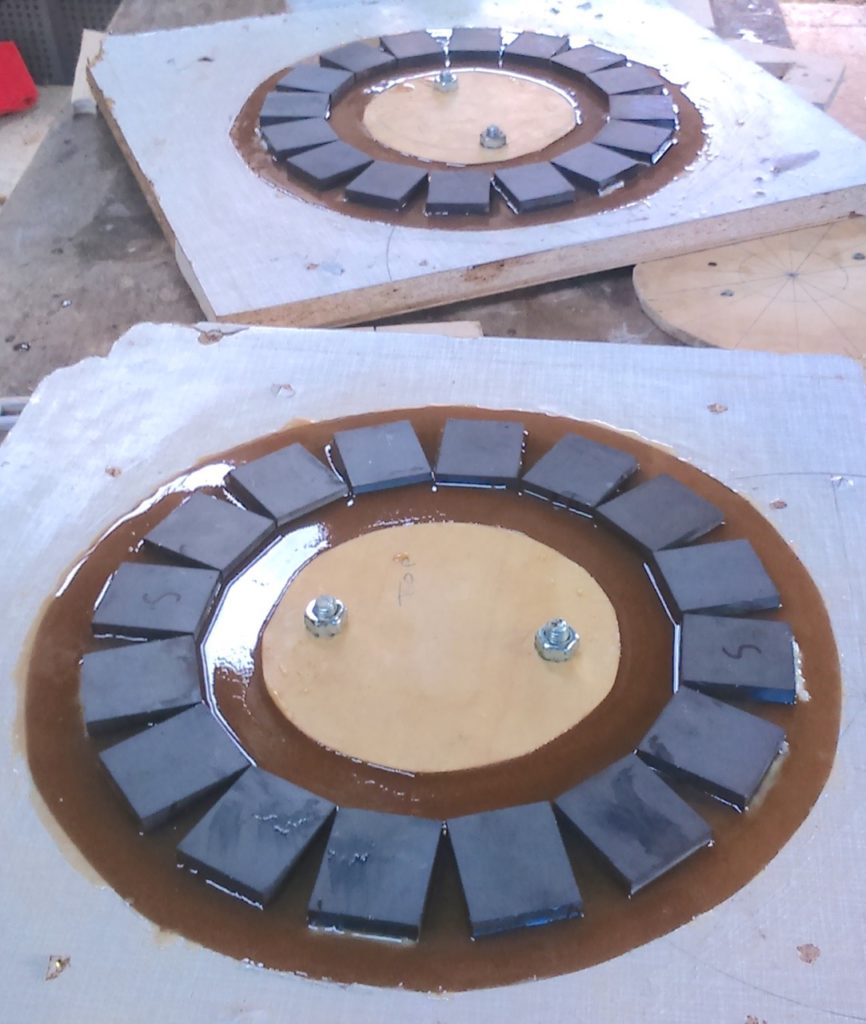My wind turbine designs in recent years have used ferrite magnets and the naming system is based on “F” for ferrite (or ceramic) magnets, preceded by number denoting the diameter in metres. Hence the 2F is my 2012 design ferrite using ferrite magnets with 2 metre blade diameter and it is the only one that is available as a finished document for sale as hard copy or ebook. I have also built 3F, 4F and several 3.6F machines and I have a designs for a 1.2, 2.4 and 5F. Details of these models are available to people who contact me and ask for them in person.

I first started building ferrite magnet machines around 1991. I produced designs for various geometries including the radial flux “Brakedrum windmill plans” and African Wind Power 3.6m turbine in Zimbabwe (AWP), and the axial flux design for ITDG/Practical Action machines in Sri Lank and Peru around 1999-2000.
Here is a detailed design document for this generation of axial flux design. In those days these magnets were expensive. This illustration below (from 2001) shows the layout with the magnets quite widely spaced. The logic was that they were costly and this layout gave me the best best “bang for my (magnet) buck”. These magnet rotors have proved extremely reliable but the power output is low, around 100-200W maximum. Good long term energy producers though.

In 2001 I got my first taste of NdFeB magnets or “neos” at a Workshop in the USA. The magnets were provided by Otherpower and they were very strong and very shiny. For the next ten years my designs were all based on these sexy new magnets. This culminated (2009) in the Recipe Book series of designs that have become very popular worldwide, leading to the creation of the Windempowerment network. Unlike the older ferrite designs they had much higher power/weight ratio, made possible by the very powerful neo magnets.

Corrosion issues in NdFeB magnets on Scoraig – The casting has been cut open for repair.
There are many machines built using these magnets, and they work well, but one persistent issue here on Scoraig (with our maritime climate) has been corrosion of the magnets. Inside their shiny coating they are extremely vulnerable to corrosion, which causes them to swell up. The resin casting fails to protect against this. When the corrosion starts at the back of the magnet (as in the above photo) the whole casting swells up and rubs on the stator. Some or all of the magnets eventually need to be replaced. Upgrading to galvanised disks helped a bit. Sometimes the issue can be dealt with for a few years using oil and grease to protect the magnets, but eventually there is a costly repair. It’s disappointing, and it has turned me back to using ferrite magnets that are immune to any kind of corrosion.
By 2012 the cost of ferrite magnets had fallen dramatically compared to the turn of the century. This enabled me to use a new approach of “throwing magnets” at the problem and so to maximise the flux in the air gap I crowded the rotor with big thick magnets, trying to fill the space. This is the opposite to my previous philosophy of trying to get the most power from the magnets I had (spaced sparsely on a large disk). Nowadays I try to get as many magnets onto the disk as I can. The optimum coil shape has also consequently changed from square with a large hole, to triangular with a small hole in the middle.


The result of this new approach is that the performance of this new generation of ferrite alternators is much closer to the equivalent sized neo alternator than one would expect, given the much less powerful magnet type. This chart compares the magnet rotor diameters. The F series are slightly larger but they produce roughly the same power output at the same rpm as the NdFeB magnet equivalents. (The 3.6F is a bit higher power than the neo one.)



Bonjour Hugh, et très bonne année 2022.
Tout d’abord un grand merci pour vos expériences très enrichissantes .
j’ai déjà construit la 2m40 en neo qui fonctionne déjà très bien , je suis a la recherche de l’autonomie totale , j’ai aussi des panneaux solaire mais l’hiver et parfois compliqué.
A priori vous avez construit plusieurs 3.6m en ferite ,est-ce bien celle qui a vos yeux fonctionne le mieux ? Si oui je veux bien les plans des rotors et du stator ainsi qu’une base pour sculpter les pales . J’ai déjà appris beaucoup grâce à vous et souhaite continuer l’aventure 😉
Merci a vous .
I have built two of your windmills, latest one 14 foot, one thousand watt. NDFEB magnets . Would like to build a larger one, and change magnet style due to corrosion. Not sure where to get plans , don’t mind paying for them . Also would like to build tidal generator, would like any info on low speed alternators, hope you can help . Thanks ! Will wait for reply .👋🙂
Hi Hugh,
We admire your work! Is there any knowledge or reported case about the loss of strength of ferrite magnets used in windturbines, maybe over multiple years?
We made an entirely 3D-printed version of the 2F-windturbine: fromwastetowind[dot]com. The magnets are spaced 1,5cm further from the center so more plastics could be fitted for additional strength. Also, we used your bladedesign spreadsheet, which gives a much wider blade root. Maybe convenience was the reason that you chose a smaller blade root?
Can we put a link to your 2F manual on our website, so people can buy it if they want to know more on the original design?
Thanks!
Bram